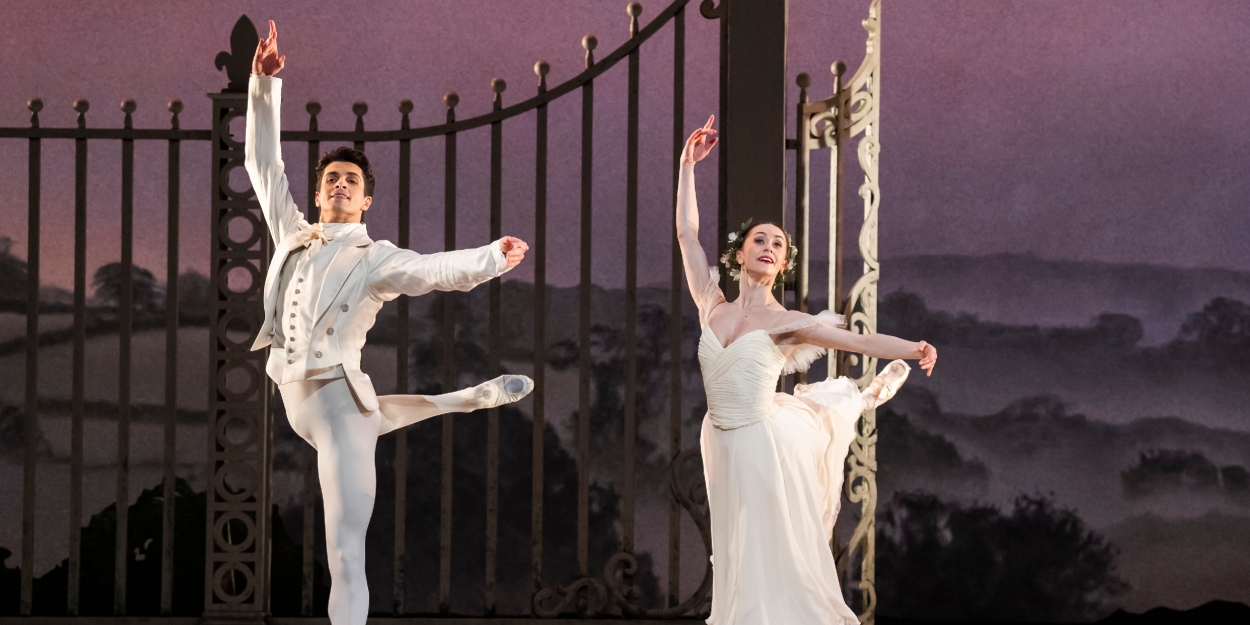Review: ASHTON CELEBRATED - PROGRAMME 1, Royal Opera House
Ashton = the King of composition

![]()
The Ashton Worldwide (2024-2028) international festival continues at the Royal Opera House with the Royal Ballet on the mainstage in Ashton Celebrated. The company is performing two mixed bills with slight repertoire changes. Both programmes include The Dream (1964) and Rhapsody (1980), which are performed on a (semi) regular basis at the ROH and elsewhere, and the opening bill also features Les Rendezvous (1933) led by Marianela Nuñez and Reece Clarke on opening night.
Les Rendezvous finds Ashton exploring familiar territory: society and socialising. And this latest production sees new sets and costumes by fashion designer Jasper Conran, which whilst elegant I also find in a very safe palette. The rigour of the work could handle something more daring and chic I'd say.
The performance by the Royal Ballet dancers is absolutely stellar, but it would be, with such rich, challenging choreography for the taking, in the extremely safe and tasteful hands of ex company dancer Vanessa Palmer responsible for the staging.
How interesting to see Nuñez out of her comfort zone, wrestling with the principal role that demands both ballerina and soubrette simultaneously, and offering them by the bucket load. But why does she look like Giselle in the afterlife Jasper? Clarke also rose to the occasion with apparent enjoyment, but needs to keep on top of the speed requirements at times.
The score by Daniel Auber, arranged by Constant Lambert froths and plays throughout, and Ashton realises this through molten transitions, effusive port de bras and tricky footwork. I adore his use of sissonne, evoking the bubbles of champagne, endlessly rising from the bottom upwards, and Ashton isn't afraid to repeat in order to make his point. Where others relent, he continues until the observer gives in, and we all did. What an opener.
Ashton’s The Dream is of course his dance version of Shakespeare’s A Midsummer Night’s Dream, and was originally created on Royal Ballet royalty Dame Antoinette Sibley and Sir Anthony Dowell in the lead roles of Titania and Oberon. Many casts have followed, and continue to, with this opening night seeing Francesca Hayward return to the role of Titania, and Marcelino Sambé as Oberon.
Without sounding too OTT, The Dream is perhaps the most ideal of ballets. A narrative that never loses potency, the Mendelssohn score that continues to conjure magic, a mystical choir, the use of mime to its absolute strength and of course, the dance.
And somehow Ashton manages to find balance within all of the above, never overselling but neither underplaying. The true sign of genius. And hooray for the use of dynamic glissade throughout!
Hayward is surely part-fairy, but could afford to hang onto moments of whimsical suspension a little more, and though Sambé's Oberon starts strong, it doesn't seem to build until the Scherzo, where he really begins to take flight. I'd also encourage more apparent projection throughout, in both his overall line and use of head. Daichi Ikarashi as Puck is working well with the role, but needs more time (post debut) to find his individual characterisation, Joshua Junker is a natural Bottom from start to finish, and the cast of mortals did super work with the Carry On style set-up.
Watching The Dream feels like the epitome of living history, and with Dowell and Sibley taking a call at the end, this became undeniable fact.
Closing the evening is Rhapsody performed by Anna Rose O'Sullivan and Taisuke Nakao, with Nakao debuting in the infamous Baryshnikov role.
Rhapsody is a gem of a work: equally sparkling and piquant, and enables Ashton to reconfirm his status as the King of composition, seamlessly switching between sumptuous adagio and crystalline allegro. Of course Rachmaninov’s Rhapsody on a theme of Paganini plays a huge role in all of this, as does the execution of a good cast.
The six soloist couples were impressive, offering effortless ballon and plenty of épaulement, though the ladies need more confidence during their arabesque pirouettes in the first entrance.
O'Sullivan is a very capable dancer and communicates command for the duration, but there's absolutely more for her to discover through the choreography: abandon within the clarity, and increased use of space for starters. Currently things feel too safe and en place.
Nakao is a real proposition: exquisite proportion, individuality, expressive port de bras and just the right level of sass. And all accomplished in his debut!
I overheard a fellow audience member describe the evening as “old-fashioned, in a wonderful way” - and if by old-fashioned they actually meant “no one else has managed this yet” - I'd be tempted to agree.
Ashton Celebrated, Programme 1 runs until June 19th
Photo credit: Tristram Kenton
Reader Reviews
Videos

